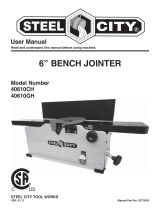
JOINTER SAFETY WARNINGS
JOINTER SAFETY
1. TOOL PURPOSE
This jointer is designed for creating flat surfaces on
wood or wood-like products only. Smoothing other
materials could result in fire, injury, or damage to
the workpiece. Using the machine for any other
purpose for which it is not designed may result in
serious injuries, machine damage and voiding of the
warranty.
2. MACHINE MOUNTING
For the operator’s safety, the jointer must be securely
mounted onto a flat and stable surface or stand.
3. PERSONAL SAFETY
•
Always wear ANSI Z87.1-approved glasses with
side shields, hearing protection, and a dust mask.
•
Do not wear loose clothing or jewelry, as they
might get drawn in by the tool. Tie back long hair.
•
DO NOT wear gloves while operating this machine.
4. ELECTRIC CORDS
Keep cords away from heat, oil, sharp edges, and
moving parts of the tool. Have an electrician replace
or repair damaged or worn cords immediately.
5. TOOL & ACCESSORIES INSPECTION
Before operation, check the tool and accessories
for any damage or missing parts. Do not use the
tool if any part is missing or damaged. Make sure
all adjustments are correct and all connections are
tight. Keep all guards in place. Make sure all moving
parts are free from interference.
6. JOINTER ACCESSORIES
• Do not use blades, or any accessories that are
damaged or worn. Replace blades as they become
damaged or dull.
• Make sure all blades and accessories are sharp
enough for the task at hand before using them.
• Make sure blades are aligned and properly attached
to the cutterhead before using your planer.
• Always turn off and unplug the unit before doing any
cleaning or maintenance. Use a brush or compressed
air to remove chips or debris. Never use your hands
to remove excess material and debris.
7. Allow the jointer to come to full speed before using
the machine.
8. WORKPIECE REQUIREMENTS
Check the workpiece carefully for splits, knots, nails,
or other obstructions. These types of blemishes may
cause a safety risk during smoothing.
9. USE HIGH QUALITY LUMBER
Blades last longer and cuts are smoother with higher
quality wood.
10. DO NOT joint material shorter than 8-1/8”,
narrower than 3/4”, or thinner than 1/4”. Never make
a jointing cut deeper than 1/8”. Use a push block or
push stick for jointing material narrower or thinner
than 3”.
11. PREVENTING ACCIDENTAL STARTING
Make sure the power switch is in the OFF position
prior to plugging in the machine. Always make sure
the power switch is in the OFF position and the
machine is unplugged when doing any cleaning,
assembly, setup operations, or when not in use.
12. SUPPORT THE WORKPIECE adequately at all
times during operation; maintain control of the
workpiece.
13. DO NOT back workpiece toward the infeed table.
14. If gluing a workpiece, always use a high quality
glue that meets the needs of the particular workpiece.
15. Take precautions against KICKBACK. DO NOT
permit anyone to stand or cross in line of the
cutterhead’s rotation. Kickback or thrown debris will
travel in this direction.
16. Do not operate this tool until it is completely
assembled and installed according to the instructions.
17. Remove scrap pieces and other objects from the
table and work area before turning ON the jointer.
18. Do not touch moving pieces. Keep hands away
from all moving parts and cutting surfaces.
WARNING! Do not let comfort or familiarity with the product replace strict adherence to product safety rules.
Failure to follow the safety instructions may result in serious personal injury.
6





















